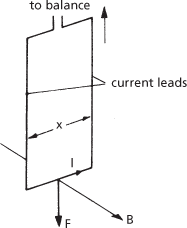An absolute means of measuring magnetic flux density, B, in air; it is capable of extremely high accuracy. This method can only be used for fairly strong fields that are uniform over a reasonable volume.
A long rectangular coil is suspended from an analytical balance with the lower end of the coil suspended in the magnetic flux that is to be measured (see diagram). The field is directed horizontally with the lower edge of the coil directed perpendicularly to the lines of B. The long sides of the coil experience no vertical force due to B, since they are vertical, and act as leads for the lower edge. Provided that these leads are sufficiently long the upper edge of the coil experiences a negligible force due to B. Thus the net vertical force, F, is just the force on the lower edge of the coil and is given by
where I is the current through the coil.
The value of I is measured using a standard resistance and potentiometer and the force F by the change in the balance reading when the current is reversed in direction. The value ∫ Bdx measured is the integrated flux density along the lower edge; the value at any point can be found if the flux-density distribution is known. If the flux is uniform along the length of the lower edge the value of B is
where x is the length of the lower edge.
Magnetic flux densities of about 0.5 tesla have been measured using this method with an accuracy of a few parts in 100 000.

Cotton balance
- intine
- Intolerable Acts
- intolerance
- intortus
- intra-
- intracellular((in biology))
- intraclass correlation coefficient
- intraclast
- intracluster correlation coefficient
- intraconnection
- intrafolial fold
- intraformational
- intrafusal
- intra-industry trade
- intra-marginal intervention((in foreign exchange markets))
- intramembranous ossification
- intramicrite
- Intranet
- intranet
- intransitive relation
- intra-orogen basin
- intraparticle porosity
- intrapreneur
- intrasparite
- intraspecific